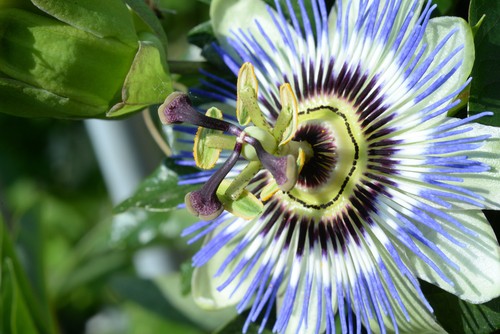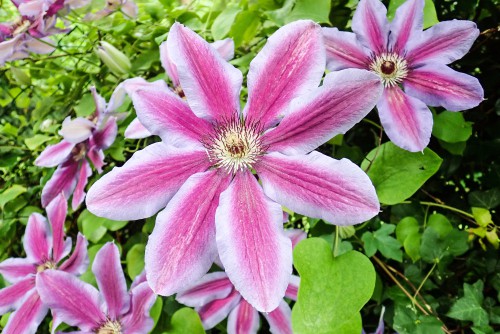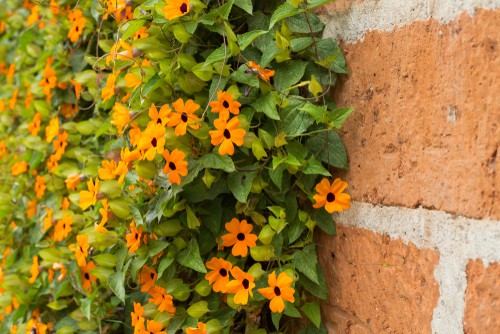Last updated on March 6th, 2022
Our site is reader supported, this means we may earn a small commission from Amazon and other affiliates when you buy through links on our site.
If you have a small space in your garden or perhaps live on a slope that is untenable as far as gardening is concerned containers might be your only option. Thankfully there are many plants that you can grow in pots, including climbers.
Best Climbers for Containers
The best climbers for containers are those that thrive well in the smaller setting of a container and will still reach maturity. Many of the plants listed below are dwarf varieties that are well-suited for pots because they aren’t as vigorous and don’t get too large.
Below we look at 10 of our favourite climbers that we love to grow in pots and containers, kicking off the list is the ‘Winter Jasmine’ that produces an impressive winter show of yellow flowers.
1. Jasminum nudiflorum – Winter Jasmine

Winter Jasmine is a vining shrub that produces yellow flowers long before you see any leaves unfurl. The bright green stems with the lemon yellow flowers are perfect for bringing any type of colour to an otherwise mundane winter landscape.
The Jasminum nudiflorum requires regular watering, more so if you are experiencing a somewhat warm and mild winter. If you have a support structure in place (such as a trellis) it will grow significantly taller because it will have the structure up which to climb.
As the name suggests, this particular variety offers flowers in the winter before the beautiful leaves show up later in the season. It is perfect for mass planting, particularly in containers used to offset an otherwise boring winter garden.
2. Jasminum beesianum – Red Jasmine

As a deciduous shrub that climbs you will enjoy fragrant flowers that take on a star shape, in tones of red or pink. This particular variety, commonly known as Red Jasmine, prefers rich soil and is a vigorous, semi-evergreen climber that is so strong it can withstand a typical frost. So, if you live in a colder area it is perfect for containers.
When you choose the location for the containers in which you will plant your flowers, try to find an area that is sheltered from severe winds, not necessarily for the sake of the plant, but so that the heavy scent it offers doesn’t get whisked away. The plant grows well in full sun or partial shade in moist, well-drained soil. It will reach a spread of 3m wide and up to 4.5m tall.
3. Passiflora caerulea – Passionflower

Exotic in their appearance the passionflowers are the quintessential tropical plant, yet they can be grown pretty much anywhere and are much hardier than they look. This species is a climbing vine that has exotic-looking flowers with a wide, flat base and the additional petals on top, in a circle shape are all offset by brightly-coloured stamens. Passionflowers require full sun to partial shade with rich, moist soil and they are actually one of the easier climbers to grow because they are self-clinging with no pruning needed.
Given that they are planted in containers you won’t need to worry so much about the soil pH, nonetheless, they are able to withstand slightly alkaline, acidic and neutral soil. In terms of the colours you can achieve with the flowers there’s almost no limit. You can enjoy blue, purple, red, pink and white, however, the Passiflora caerulea (pictured above) is probably the hardiest and some varieties are tender in comparison.
These particular plants are heavy feeders so they will benefit from an all-purpose fertiliser as soon as new growth starts to emerge in the spring, and then every four or six weeks until the beginning of autumn. Other than that, they are incredibly low maintenance plants and require no deadheading or pruning.
4. Trachelospermum jasminoides – Star Jasmine

The Star Jasmine is a beautiful climber that is well known for its fragrant star-shaped flowers. Those flowers are offset by a thick blanket of rich green foliage. These are best when planted in containers and placed in frost-free areas so that they can be trained up walls or trellises. If you plant them near a patio or a terrace you can enjoy the beautiful fragrance they have when you are outside.
For colder areas, this is the perfect summer container plant. The Trachelospermum requires partial to full sun and weekly watering. They grow very quickly and bloom from spring through summer. They are ideally suited for rustic or cottage gardens. They can be a little tender so are best placed in a sheltered position.
5. Clematis ‘Carnaby’

In order to create an enhanced space offset by larger blooms, this early, large-flowered clematis, is the perfect addition to your home. The flowers are compact and raspberry pink spanning up to 20cm across. They have a beautiful exterior of white, lined with a rich pink stripe up the centre. As the flowers open they become flat like saucers and you will get to enjoy two waves of flowering, one of which comes at the end of spring and another that comes at the beginning of autumn.
Perfect for containers, this clematis can be deadheaded after the first wave to promote more growth. It will grow very quickly though and as a climber, it is best to give it something to climb up. This variety will do well throughout the season if left unpruned and then hard pruned every three years at the end of winter, as you do with all group 3 clematis.
6. Clematis florida ‘Sieboldiana’

This clematis is well known as a deciduous climber and this particular variety is one that has some of the most uniquely beautiful flowers. When in full bloom you will enjoy six beautiful petals and in the centre of these is a rich purple stamen with a green centre that draws the eye.
The flowers produced span between 7cm and 10cm across and they will produce the main flush at the end of spring and beginning of summer, they then rebloom sporadically well into autumn. It is truly one of the most beautiful clematises for containers. It thrives in full sun in order to generate better flowers, so if at all possible you want to keep the container with the roots cool but the top of the plant in the sun.
It can grow very quickly if given the right conditions and will reach between 180cm and 240cm, so make sure that you have the space to support such growth when you put your planters in the garden.
This plant can be a bit more challenging to grow if there’s a fluctuation in weather. Because the Sieboldiana it is part of the second group of clematis, this means it flowers in the early summer on the short shoots that develop on the growth from the previous season, and then again in the autumn on the growth from the current season, so you will either need to prune it at the end of winter or before the flowering season begins.
7. Miniature Climbing Rose ‘Lavender Lassie’

This is a fragrant miniature climbing rose that produces semi-double, pink flowers and can grow up to 2.5m tall and wide. This is better suited for large containers and as a hybrid, it is much more tolerant of shade than other roses. As a result, it is a better climber for pots in back gardens, on patios or decking that may not get daily sunlight.
It requires moist, well-drained soil and good circulation. It is important that once you plant it you remove fallen leaves from the base of that container/pot to help prevent diseases from spreading.
You can regularly prune it on a light basis or alternatively prune it back by up to a third of its size annually. This particular rose can be propagated with softwood cuttings in the spring or hardwood cuttings in the autumn, so once you have one thriving plant you can use it to create a collection in your garden.
8. Wisteria ‘Amethyst Falls’

Ideally suited for smaller spaces, this twining climber grows at a third of the rate of regular Wisteria, this means it will bloom at a very early age and provide you with purple flowers that gracefully sweep downwards and continue to grow slowly but surely thereafter. They are perfect for small patios or porches and will train quite well up a trellis or an arbour, however, if left alone can be crafted into a small, free-standing tree.
This deciduous plant requires partial to full sun and weekly watering. The average size for the stems can reach up to 2m long when it is fully established, but this can obviously be pruned back to fit your garden. The foliage is green and complemented by fragrant, purple flowers that repeatedly flower throughout the season. They start with the heaviest bloom in late spring and repeat again lightly during the summer.
9. Rhodochiton atrosanguineus

These are very exotic-looking perennial climbers that produce heart-shaped leaves and pendant flowers in a deep purple colour. These will be produced in succession starting at the end of spring and going through the remainder of the season.
There are bright bell-shaped calyces and then purple petal tubes that hang from those. After pollination, the tubes fall away but you get to enjoy the sepals thereafter. These will reach 7cm and will successfully coil around any support structure you use.
They are a free-flowering climber that requires very little care and can be grown outdoors successfully in containers but need cutting back in autumn and keeping in a greenhouse or conservatory over winter because they are tender.
They are generally disease-free and require morning sunlight but afternoon shade. They thrive in moist, well-drained soil or shrub compost if grown in pots. If you plant them in pots or containers be sure to give them a trellis, pergola or wall to climb up. They will do well with acidic, neutral or alkaline soil and will reach a height of up to 3m and a spread between 30cm and 60cm each season.
No products found.
10. Thunbergia alata – Black-Eyed Susan

Black-Eyed Susans are a very popular wildflower and part of the sunflower family. They get their name from the dark purple/brown centre they have surrounded by daisy-like yellow petals. These attract a variety of insects, including bees and butterflies for their nectar and will produce stunning flowers from June through to October. Black-Eyed Susans tend to be quite territorial, which means they will interfere with any other flowers attempting to grow nearby. This is what actually makes them perfectly suited for pots because there won’t be any competition.
When you plant these they need moist, well-drained soil and they prefer full sun but will develop just fine in partial sun. Be aware of where you want to put the pots or containers you are using, especially if you are going to grow them in a large container that might become too heavy to move once it has been filled. Black-Eyed Susans can reach up to 1m in height and spread up to 30cm across so plant them closer together to prevent them from spreading too far in the pots or plant them farther apart if you are using a long container and want the Black-Eyed Susans to create a border.
These do need regular watering so that they don’t dry out and you can deadhead after the first flush of flowering to enjoy a second flush later in the autumn. It is a tender perennial so you will need to bring it into a warm conservatory or greenhouse over winter. Failing that, you can replace them every spring and treat them as an annual because they are fairly fast growing anyway.
Last update on 2025-10-17 / Affiliate links / Images from Amazon Product Advertising API









